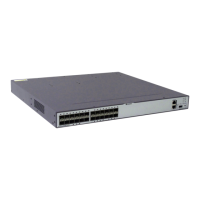Route reflection between clients is disabled.
If the clients of the route reflector are full-meshed, you can use the undo reflect between-
clients command to disable the route reflection between the clients. This reduces cost.
By default, the route reflection between clients is enabled.
This command is used only on the reflector.
----End
8.11.4 (Optional) Configuring the Cluster ID for a Route Reflector
When there are multiple route reflectors in a cluster, you need to configure the same cluster ID
for all the route reflectors in this cluster to avoid routing loops.
Context
Do as follows on the BGP4+ switch:
Procedure
Step 1 Run:
system-view
The system view is displayed.
Step 2 Run:
bgp as-number
The BGP view is displayed.
Step 3 Run:
ipv6-family [ unicast ]
The BGP IPv6 unicast address family view is displayed.
Step 4 Run:
reflector cluster-id cluster-id
The cluster ID of the route reflector is set.
TIP
When there are multiple route reflectors in a cluster, you can use the command to configure all the route
reflectors in this cluster with the same cluster ID. This avoids routing loops.
----End
8.11.5 Checking the Configuration
After a BGP4+ route reflector is configured, you can check BGP4+ route information and peer
group information.
Prerequisites
The configurations for a BGP4+ route reflector are complete.
S6700 Series Ethernet Switches
Configuration Guide - IP Routing 8 BGP4+ Configuration
Issue 01 (2012-03-15) Huawei Proprietary and Confidential
Copyright © Huawei Technologies Co., Ltd.
535

